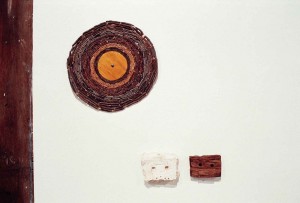Sound fills the art world. Upon entering almost any contemporary gallery space we hear sound emanating from TV monitors, projection spaces, computers, and in headphones, not to mention the echoes of voices and footsteps. The gallery is not the hushed space it was once imagined to be, but filled with noisy, quiet, disruptive, overlapping, discrepant, loud, brutal, pretty, aggressive, harmonious sounds. This is not unproblematic as the hard square surfaces of the gallery do not manage sound well; it echoes around the space, bumping into sound that has crept out of adjoining galleries, and in the process it interferes and merges with it. In addition many contemporary practices stage the gallery as a social space, somewhere we have conversations, eat, drink and participate. Yet the exhibition of sound in contemporary art practice has been given very little critical attention.

2. Vicky Browne, Calling Occupants (detail), 2006, installation view, from the exhibition Mistral curated by Caleb Kelly for Artspace, Sydney. Image courtesy the artist. Photograph by Mr Snow.
To begin with, compare two very different environments for the display of audiovisual work: the cinematic theatre and the contemporary art gallery. The former is dark, plush and comfortable, the latter is white, stark and far from comfortable. The cinema was created for viewing moving images and listening to highly produced audio, while the gallery space was created for viewing visual art. It could be argued the cinema attempts to lull us into forgetting our presence in the theatre, while the art gallery constantly alerts us to the fact that we are looking at art and present. The venues for film and contemporary art have a relatively short, but deliberate history, and the rationale behind these discrepant architectures displays a very different approach to what was expected to be presented in the spaces. Architecture is constantly changing, as are the rationales for conceptualising gallery space. It is high time that these spaces were reconsidered within the framework of contemporary practices.
[For more, read the special Arts of Sound November 2009 Issue of Art Monthly Australia www.artmonthly.org.au]
Caleb Kelly
Caleb Kelly is a lecturer at the Sydney College of the Arts. His first book Cracked Media has recently been published by MIT Press, and he is currently working on an anthology entitled Sound for the Documents in Contemporary Arts series published by Whitechapel Gallery and MIT Press.
 This work is licensed under a Creative Commons Attribution-NonCommercial-ShareAlike 2.5 Australia.
This work is licensed under a Creative Commons Attribution-NonCommercial-ShareAlike 2.5 Australia.






